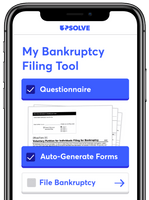Repossession After Bankruptcy: What You Should Know
Upsolve is a nonprofit that helps you get out of debt with education and free debt relief tools, like our bankruptcy filing tool. Think TurboTax for bankruptcy. Get free education, customer support, and community. Featured in Forbes 4x and funded by institutions like Harvard University so we'll never ask you for a credit card. Explore our free tool
You have options for what to do with a car loan when filing a Chapter 7 case, including reaffirmation, redemption, or surrender. Entering into a reaffirmation agreement can lead to new debt problems if you default on your car loan payments after bankruptcy. The purpose of filing Chapter 7 bankruptcy is to put you in a better financial situation than before filing and give you a fresh start. Keep reading to find ou Filing for Chapter 7 bankruptcy can erase your personal responsibility for a car loan, but it doesn’t eliminate the lender’s right to repossess the car if you stop making payments. If you want to keep your car, you’ll need to decide whether to continue paying the loan, negotiate better terms, or surrender the vehicle during the bankruptcy process. Each option — reaffirmation, redemption, or surrender — has its own risks and benefits. what to expect if your car is repossessed after filing Chapter 7 bankruptcy.
Written by Attorney Jenni Klock Morel. Legally reviewed by Jonathan Petts
Updated January 2, 2025
Table of Contents
- Can You Keep Your Car if You File for Bankruptcy?
- Can Your Car Be Repossessed After You File for Chapter 7 Bankruptcy?
- What Are Your Options for Handling a Car Loan in Chapter 7 Bankruptcy?
- What Happens If My Car Is Repossessed After Bankruptcy?
- How Can You Avoid Losing Your Car After Filing for Bankruptcy?
- Is It Possible to Get a New Car After Bankruptcy?
- Let's Summarize...
If you're worried about losing your car after filing Chapter 7 bankruptcy, you're not alone. People file bankruptcy to get a fresh financial start, but many still have questions about how their car loan is handled. The good news is that bankruptcy gives you options, whether you want to keep your car or let it go. In this article, we’ll explain what happens to auto loans in Chapter 7 bankruptcy, what to expect if your car is repossessed, and how to avoid repossession altogether.
Can You Keep Your Car if You File for Bankruptcy?
Whether you can keep your car after filing for bankruptcy depends on your financial situation, the type of bankruptcy you file, and the value of the car compared to what you owe on it.
In Chapter 7 bankruptcy, you can keep your car if its equity is covered by a state or federal bankruptcy exemption and if you’re able to stay current on your loan payments. Equity is calculated by subtracting what you still owe on the car loan from the car’s current fair market value.
However, if the loan is unaffordable or the car is worth much less than you owe, you might choose to surrender it as part of the bankruptcy process.
In Chapter 13 bankruptcy, the rules are a bit different. Chapter 13 lets you catch up on missed car payments through a repayment plan, which can help you keep your car even if you’re behind. In some cases, you may also be able to reduce the loan balance or interest rate.
Can Your Car Be Repossessed After You File for Chapter 7 Bankruptcy?
When you file for bankruptcy protection, the automatic stay takes effect, which stops all collection activities. This includes wage garnishment, car repossession, eviction, foreclosure, and harassing collection phone calls. But the automatic stay is terminated once your discharge is entered. This is the court order that relieves you of paying certain debts.
Filing for Chapter 7 bankruptcy can erase your personal responsibility to pay a car loan, but it doesn’t erase the lender’s lien on your car. A lien is a legal claim that lets the lender repossess your vehicle if you stop making payments. This is because car loans are secured debts, meaning the car itself acts as collateral for the loan.
Here’s what this means for you: If you want to keep your car, you must continue making payments, even after your bankruptcy is complete. And if you fall behind on payments, the lender can legally repossess your car, even after your bankruptcy discharge.
The only way to remove the lien from your car is to pay off the full loan balance or negotiate new loan terms during bankruptcy, which we’ll explain below.
Secured vs. Unsecured Debts in Bankruptcy
A secured debt is a loan that is backed by collateral, which is an item of value that the lender can take if you don’t repay the loan. The collateral acts as a guarantee for the lender, reducing their risk. This gives the lender a legal claim, called a lien, on the property until you fully repay the debt. If you stop making payments, the lender can seize (or repossess) the collateral to recover their money.
Common examples of secured debts include:
Car loans: The car serves as collateral for the loan. If you stop making payments, the lender can repossess the car.
Mortgages: The home is the collateral for the loan. If you default, the lender can foreclose on the house.
Secured personal loans: These loans may be backed by assets like savings accounts, jewelry, or other valuable items.
In contrast, unsecured debts — like credit cards, medical bills, or personal loans — aren’t tied to any specific property. If you fail to pay an unsecured debt, the creditor can’t take property from you, but they can use other collection methods like lawsuits or wage garnishment. Most unsecured debts are wiped out in Chapter 7 bankruptcy.
What Are Your Options for Handling a Car Loan in Chapter 7 Bankruptcy?
When you file Chapter 7, you’ll need to decide how to handle your vehicle loan. You have three main options under the U.S. Bankruptcy Code: reaffirmation, redemption, or surrender. Each option has pros and cons depending on your financial situation.
Option 1: Reaffirm the Car Loan (Reaffirmation)
Reaffirmation allows you to sign a new agreement with your lender during your bankruptcy case. This means you get to keep the car, but it also makes you personally liable for the loan again — even after your bankruptcy discharge.
Reaffirmation often makes sense for people whose car loan is affordable and who need a car for work or family obligations. Reaffirmation does come with some risks though. The biggest risk is that if you reaffirm the loan and later fall behind on payments, the lender can repossess the car and come after you for the remaining loan balance — the deficiency balance — and repossession costs. This means they could sue you or garnish your wages.
If your monthly payments are too high or the car’s value is less than what you owe, reaffirmation may not be your best option. If you aren’t sure what’s best for you, you can schedule a free consultation with an experienced bankruptcy attorney to get personalized legal advice about your situation.
If you want to reaffirm your loan in your bankruptcy case, you’ll need to have your reaffirmation agreement approved by the bankruptcy court.
Option 2: Redeem the Vehicle (Redemption)
Redemption allows you to buy your car outright during bankruptcy by paying the lender its current market value in a single lump sum, instead of paying the full loan balance. This can be a great option if your car is worth much less than what you owe on the loan.
If your car’s market value is low and you can find the funds for a lump-sum payment, redemption can save you money. Many people use savings, borrow from family or friends, or take out a redemption loan (a new loan to pay off the redemption amount). If redemption doesn’t make sense for your situation, you can choose to surrender the car.
Option 3: Surrender the Vehicle
Surrendering your car means giving it back to the lender. If you choose this option, your car loan — and any remaining balance after the lender sells the car — is wiped out in your bankruptcy discharge.
If your car loan payments are too high, your car has a lot of miles or repairs, or you simply can’t afford it, surrendering may be the best way to free up money for other expenses. The lender will repossess and sell the car, but you won’t owe anything on the loan after the discharge is complete.
If you surrender your car, you may be able to replace it with a more affordable car after your bankruptcy case is over. If you get a car loan, your interest rate may be high, but many people still qualify for car loans after bankruptcy.
What Happens If My Car Is Repossessed After Bankruptcy?
If your car is repossessed after your Chapter 7 bankruptcy is complete, your next steps depend on whether you reaffirmed the loan or not.
If You Reaffirmed the Loan…
If you signed a reaffirmation agreement, you’re still personally responsible for the car loan even after bankruptcy. This means that if you fall behind on payments, the lender has the right to repossess the car. Once the car is repossessed, the lender will likely sell it, often at auction. If the sale price doesn’t cover the full amount you owe — plus any repossession costs — you’ll be responsible for paying that remaining amount, called a deficiency balance.
The lender can take further collection actions to recover this balance, including suing you for the unpaid amount or garnishing your wages. This is why reaffirmation carries significant risks, especially if the loan terms are unfavorable or the payments are more than you can afford.
If You Didn’t Reaffirm the Loan…
If you didn’t reaffirm your car loan, your responsibility to pay it was discharged in bankruptcy. This means that the lender can repossess the car if you don’t make payments, but they can’t come after you to pay a deficiency balance. And even if the lender repossesses and sells the car for less than the loan balance, you’re not personally liable for the difference.
In many cases, lenders don’t repossess a car unless you stop making payments, even if the loan wasn’t reaffirmed.
How Can You Avoid Losing Your Car After Filing for Bankruptcy?
If you want to keep your car, here are some tips to help you avoid repossession:
Stay current on payments: The most important thing you can do is make your monthly car payments on time. Consider setting up automatic payments to avoid missing due dates.
Explore refinancing options: After bankruptcy, you may be able to refinance your car loan to get a lower monthly payment.
Downsize your vehicle: If your car payments are too high, consider trading in your vehicle for a cheaper one or selling it yourself to pay off the loan.
Reevaluate your budget: Adjust your spending to prioritize essential expenses, like your car payment, to avoid falling behind.
If you’re struggling to make payments even after a fresh start in bankruptcy, surrendering the car might still be the best option to avoid future financial strain.
Is It Possible to Get a New Car After Bankruptcy?
Yes, it’s possible to get a new car after bankruptcy, even if you lost your previous vehicle to repossession or surrender. Your ability to finance a car will depend on your financial situation and your credit score after bankruptcy. While bankruptcy can lower your credit score in the short term, many lenders offer car loans specifically designed for people who’ve recently filed bankruptcy.
These loans may come with higher interest rates, so it’s important to focus on finding a reliable, affordable vehicle with a monthly payment that fits your budget. Taking on an expensive or risky loan right after bankruptcy could create financial strain and undo the progress you’ve made. As you rebuild your credit by paying bills on time and keeping debt low, you’ll be in a better position to refinance or qualify for better loan terms in the future.
Let's Summarize...
When you file for Chapter 7 bankruptcy, you have three main options for handling a car loan: reaffirmation, redemption, or surrender. Each option has its benefits and risks, so it’s important to choose the one that aligns with your financial situation and long-term goals.
Reaffirmation can be risky because it makes you personally liable for the car loan after bankruptcy. If you default on payments, you could face repossession and financial hardship. This is especially problematic if your car loan has high monthly payments, if the loan has a steep interest rate, or if you owe more than the car is worth.
If you have a simple Chapter 7 case, you may be eligible to use Upsolve’s free web app and file your case without a lawyer. If your case is complicated or you simply want some legal help, we can also help you schedule a free consultation with a local bankruptcy lawyer.













